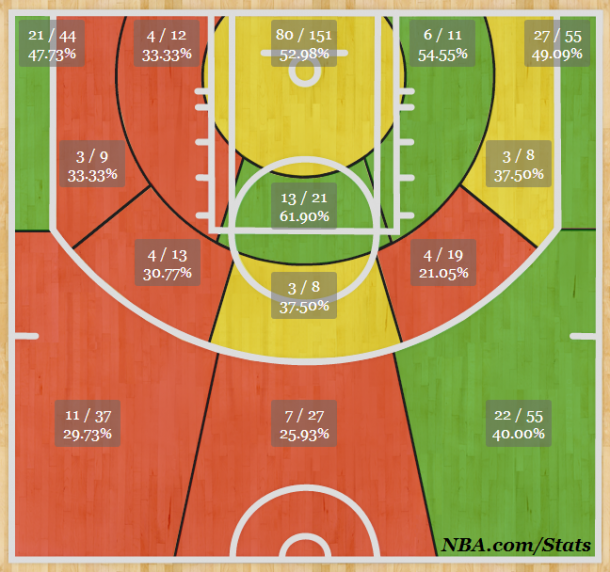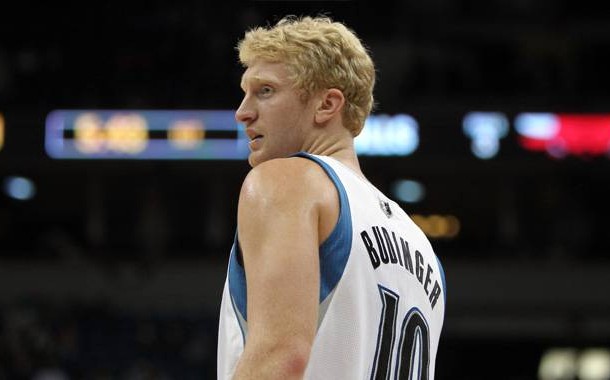Photo Credit: Brace Hemmelgarn-US PRESSWIRE
The Basics
Height: 6-7
Wingspan: 6-7
Weight: 218
Experience: 4 years
Teams: Rockets, Timberwolves
Quick Hits
Lives on the 3 point line on offense
Has never started the majority of his games
Once a high-flying athlete. Has his knee healed?
Good defender
His Offensive Game
Budinger’s offense stems from his ability to shoot. The threat of him spotting up is enough to draw defensive attention, which he can exploit by driving in straight-lines to the basket. He isn’t someone you throw the ball to and ask to create, but he can certainly spot up and hit shots.
Budinger is also a good passer who can hit his teammates with passes in the right spots, with the right speed, and at the right time. He won’t have you screaming “point forward,” but he can dump off to bigs, throw skip passes, and hit the roll man with pocket passes.
His Defensive Game
Budinger is by no means a defensive stopper, but he is conservative and smart. He isn’t a gambler and won’t fill the stat sheet with steals and blocks, but he does a good job staying in front of his man and baiting him into jumpers. This appears to be Budinger’s mantra- he’ll sacrifice a little space to prevent his man from getting into the paint, at the cost of giving a little daylight for his man to pull-up and shoot.. and I’m very happy with that.
Rebounding Rates (in % format, via HoopData)
Emboldened numbers indicate that Budinger’s rate exceeded the league average for his position.
| 09-10 | 10-11 | 11-12 | 12-13 | |
|---|---|---|---|---|
| Budinger ORR | 2.8 | 3.4 | 3.4 | 3.1 |
| Leauge Average (SF) | 4.7 | 4.2 | 4.3 | 4.8 |
| Budinger DRR | 14.5 | 14.9 | 16.1 | 13.5 |
| Leauge Average (SF) | 13.9 | 13.9 | 13.6 | 14.8 |
| Budinger TRR | 8.4 | 9.1 | 9.7 | 8.1 |
| Leauge Average (SF) | 9.3 | 9.1 | 9.0 | 9.8 |
- Budinger graded anywhere from an above-average rebounder to a below-average rebounder for total rebound rate. His 2012-2013 numbers probably reflect a decrease in athleticism following the knee injury he sustained during the season.
- His total rebound rate increased every year before his short season last year, and I would expect his total rebound rate to significantly differ from the 8.1% he posted last season.
- Budinger is an above-average defensive rebounder, but a below-average offensive one. His offensive rebound rate will probably remain below-average, as he is not an aggressive player and tends to camp out on the perimeter.
Scoring in Detail (via nba.com/stats)
*Note: I chose to use Budinger’s shot chart from his last year with the Rockets (2011-2012), rather than use last year’s shot chart, which had meaningless sample sizes.

Notes from Chart
- The first, and most important note, is that the sample sizes from some of these ranges are very small. The larger the sample size, the more we can draw from the numbers.
- As I mentioned before, Budinger is primarily a 3 point shooter, and this is evident in the statistics. He is best served shooting from the corner, which is no surprise, as the corner 3 is the closest spot to shoot from downtown. Budinger shot an impressive 48 for 99 (48%) from the corners.
- Budinger also has a high volume of shots around the basket, which typically came from transition buckets, drives after kick-outs, and cuts to the basket. It is worth noting that this range is not the equivalent of “finishing at the rim.” The space depicted near the basket encompasses a larger area. Budinger finished with a field goal percentage of 65% at the rim in this particular year.
- Budinger was more effective shooting above the break from the right side of the floor than he was from the center or left.
How He Fits
If Gordon remains a Pelican for the upcoming season, the Pelicans will sport a backcourt of two guards (Gordon, Holiday) who are very good at getting into the paint. In order to tailor the lineup to their strengths, the Pelicans should add a 3 who can stretch the floor, and Budinger can do just that. Budinger’s ability to put the ball on the floor to beat a poor close-out would also be beneficial for a New Orleans team that never established a wing threat last year.
Budinger has also been good getting out in transition and filling lanes, and the core of the Pelicans is well-suited for running the floor. Coach Monty Williams has always employed a slow pace on offense, but having players who can run the floor would be beneficial, especially with two athletic guards in Gordon and Holiday. Budinger can finish alley-oops and can also spot up for 3s in transition. Generating just a few easy looks in transition would greatly benefit the Pelicans.
Why You Should Want Him to Sign
Budinger is not the ideal prospect to slide in and start for the New Orleans Pelicans. There are many other free agents who could step in and do a better job, but most will be more expensive and may be harder to obtain. Budinger’s appeal comes into play if the Pelicans can’t grab a higher-quality free agent: he’s young, can shoot and defend, and he would serve as a decent stop-gap until Dell Demps could find a better SF. If nothing else, he would be another cheap option at a position that the Pelicans struggled to get production from last year.
Expected Contract
2 years, $5-8 million
Budinger, as mentioned before, sustained a knee injury last year and only played in 23 games. He has been a backup his entire career and has averaged just over 20 minutes per game every season. There is no reason to think that he will receive a substantial contract this offseason, particularly with wings like Andre Iguodala and Andrei Kirilenko on the market. The Timberwolves are rumored to want him back.

15 responses to “SF Prospect: Chase Budinger”
Oh you guys at BSS are going to have fun with this SF search aren’t you!!! I dropped a question about Derek Williams on a previous article. Is $5mil too much for a “Combo” forward?
I think the bigger question is what it would take to snag him from Minny.
If he came to us i feel he’d get better, as getting more minutes will help him do more and become a more impactful player!
I’ve always enjoyed Chase Budinger, ever since his days as a rookie with the Rockets. Wouldn’t mind having him on the team at all.
Andre Iguodala is perfect to the Pelicans! Go, Demps!
Perfect at what price though? His numbers declined a bit this year and his game is highly reliant on his elite athleticism. He’s a great fit now, but I’m not convinced about his game continuing to stay at a high level. Just look at what has become of Gerald Wallace. While Iggy is more skilled than Wallace was, are you sure that getting him is a great move as Iggy continues to move toward the wrong side of 30?
I like Derek Williams but didn’t Minnesota just said they weren’t shopping him? I don’t really believe that though. He would be a starter with us and you got admit it gets your juices going. I think he’d be a perfect fit for us we should pitch him on no snow to shovel in the winter, right? LOL. AI wants big bucks and unless he really wants to reunite with Jrue, he seems to be an impossibility. I also like Earl Clark.
LaNative I had considered the reunion aspect when thinking they were going after Iggy. Jrue and Iggy played together for a few years.
Budinger is the perfect 2nd team SF who can join the 1st team in spurts to open the court for drives, and he is priced accordingly. Wouldn’t be surprised to see the Pels sign two new, relatively inexpensive, SFs this off season with some differences in their games.
Also, I am not ruling out bringing Aminu back for cheap as a 5th forward. His athleticism and durability are still valuable.
504ever could happen that way, will depend on what he can get on the market. And btw, in response to your comment on Mason’s- we are just putting up some info on guys we think could fit or could be targeted.
No writer has an agenda to beat another. No matchups like the 6th pick tournament. Just putting some info out there
palochak 504ever
I would report on the options from worst to best (understanding there may be ties or tiers) if I ran this site. That way everyone reads them all. That’s not an agenda, just a way maximize site interest.
Chase looks like Drago from Rocky 4
Copeland is better and cheaper IMO.
I continue to be blown away, piece after piece. The information seems is boundless.
Seems like someone who still needs a lot of coaching / development. Wouldn’t mind us getting someone a little more seasoned, a leader not a follower